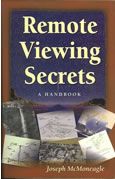|
The "science" of studying the remote viewing phenomenon is different from the "process" of remote viewing itself. The science of remote viewing addresses the issue of proving that the phenomenon exists, and this can range from detailed descriptions of laboratory set-ups to statistical analyses of numerical data. The process of remote viewing involves a discussion of how remote viewing itself works. Process discussions primarily address experiential issues, but they can also involve detailed examinations of both raw and statistical data. But the emphasis of process discussions is not to prove that the remote viewing phenomenon actually exists. Process discussions begin with the assumption that remote viewing is a real phenomenon, and then proceed to an examination of how the quality of the phenomenon varies under differing conditions while using specified methodologies. Remote Viewing Secrets, by Joseph McMoneagle, is a valuable process-oriented treatment of remote viewing, and a significant more general contribution to the growing literature in this new and rapidly growing field. This is Mr. McMoneagle's third book on the subject of remote viewing, and it is by far the most in-depth exposition to date of his perspective on the way in which high-quality remote viewing should be accomplished. He begins by outlining the various levels of remote-viewing ability, and he crafts the useful analogy with martial arts where belts are used for ranking participants (such as a "black belt" in karate). He then describes from his own experience what remote viewing can and cannot accomplish, which is a useful point to make since so many people new to remote viewing mistakenly think that RV can be used to perceive just about anything with great accuracy, especially numbers on a lottery ball. Indeed, it seems to be a characteristic of Mr. McMoneagle that he seeks to restrain others from having unrealistic expectations with regard to both their own capabilities as remote viewers as well as the potential of the phenomenon of remote viewing itself. In numerous places in this book it is clear that Mr. McMoneagle is vitally concerned about remote viewers as people, and in this respect he is probably one of the most cautionary voices in the practicing RV community at the current time. His view is that the mental state of the remote viewer is crucial to both the viewer's success rate and the desirability of that person to participate in remote viewing in the first place. Yet he sometimes seems to contradict himself when at one point he seems to suggest that only the most gifted individuals be selected for RV training, but then claims that almost anyone can become the equivalent of a black belt in remote viewing as long as they have the long-term motivation to do so. I suggest that this apparent contradiction actually reflects a level of uncertainty that exists in the entire RV field, and Mr. McMoneagle is simply seeing the picture from various perspectives without firmly committing himself to only one point of view. This is not a criticism of Mr. McMoneagle by any means, as no one really knows with certainty the parameters of what makes any particular person a good candidate for learning a remote viewing methodology. Nonetheless, the cautionary side of Mr. McMoneagle's voice is exceptionally welcome in this relatively new field where clear boundaries and parameters on a wide range of issues are yet to be established. Much of the remainder of the book deals with a myriad of detailed subjects relating to the process of remote viewing. This includes how to keep records, types of targets, conditions under which to remote view, times to remote view, discussions of various RV methodologies, meditation, dowsing, ethics, and more. In short, this book is a comprehensive treatment of Mr. McMoneagle's overall perspective on the practice of remote viewing. It is an invaluable book for those who want to obtain a background on the subject that has significant breadth. Mr. McMoneagle's appreciation for the science of remote viewing makes his perspective on the process of remote viewing all the more valuable. This book is a "must read" for anyone serious about learning how to remote view, and it is a highly recommended book for those with more modest aims who simply want to know more about the subject. |

